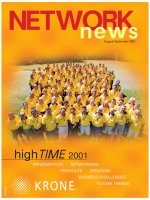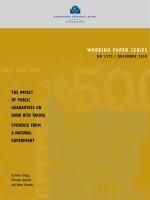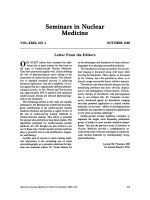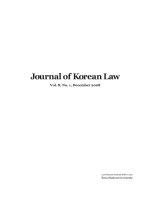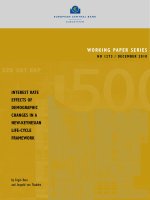TESOL QUARTERLY Vol. 44, No. 4, December 2010
Bạn đang xem bản rút gọn của tài liệu. Xem và tải ngay bản đầy đủ của tài liệu tại đây (43.55 KB, 4 trang )
In This Issue
doi: 10.5054/tq.2010.238884
& With this issue we mark the end of the first year of our co-editorship of
TESOL Quarterly. To say it has been an interesting year would be a gross
underrepresentation of what we’ve experienced. On the technical side
there has been the full-scale transition to our online editorial management
system, which, with the expert technical support we have received, has
occurred quite smoothly. Along with this transition, there has been an
intriguing affective outcome of which we both have become mindful. In the
traditional print-based system, communication between editors, authors,
and reviewers was more direct and more personal. Manuscripts really were
sent to an editor; invitations to review manuscripts came directly from
editors to the reviewers, leaving space for personal remarks and appeals if so
desired. By contrast, manuscripts are now sent to a system, not to an
individual editor, and review invitations, along with thank you messages to
reviewers, are generated automatically by the system. This shift to the online
system has allowed for the kind of efficiency that is crucial to running a
journal like this one, where hundreds of manuscripts arrive per year and
over a thousand review invitations are sent, but we have received some
interesting and thought-provoking push-back from reviewers and authors
who have been troubled by the impersonal nature of the communication
that is part and parcel of an online system. In response to these concerns,
we have made an effort to monitor these automatic communications more
closely and personalize them to the extent we can. We are convinced,
however, that what might have been lost in the way of a more personal touch
is more than compensated for by the ease and speed with which authors,
reviewers, and we, the editors, can now communicate with each other.
International participation in the submission and review processes has
definitely been facilitated by the web-based system.
Moving to what might be called the content side of the journal, we have
found ourselves wrestling with some challenging issues. One of those is the
role or importance of empirically based research articles as compared to
other kinds of full-length manuscripts, such as what are often referred to as
thinkpieces, a genre that includes but goes far beyond literature review in
challenging us to rethink our taken-for-granted theoretical and methodological stances. A closely related issue is what constitutes quality research.
We are acutely aware of the fact that the types and quality of research we
publish in TQ send a message to the larger TESOL community as well as to
those in closely related communities. We also know that new approaches to
research continue to emerge, just as new perspectives develop, particularly
as the world of research is changed by the increasing diversity of the
researchers who produce it. In the early days of TQ, research came only
from researchers located in a few parts of the world, and from a relatively
TESOL QUARTERLY Vol. 44, No. 4, December 2010
643
small group of people who generated it. Nowadays it comes from nearly
every part of the world, as do those who review it. There is a fascinating
multivocality at work as the range of those who produce and evaluate
research increases steadily. There are more voices than ever before
commenting, in manuscript reviews, on what constitutes appropriate
research for TQ, just as there are more authors from ever-widening
backgrounds shaping or challenging notions of research as they generate
and share that research with us. As editors, we welcome the opportunity to
participate in this global reconsideration of what research is and in the
negotiation that plays out between writer aims and reader expectations in
every manuscript review process.
From a research perspective, this issue of TQ is an especially exciting one in
the way it represents the diversity found in the research submitted to the
journal in terms of methods employed and those who are the participants in
the research process.
Junko Yamashita and Nan Jiang included research participants at
universities both in Japan and the United States in their examination of
performance on a phrase acceptability judgment task that presented the
participants with congruent and incongruent English-language collocations,
that is, those with and without counterparts in the language learners’ L1, in
this case, Japanese. Interestingly, both the EFL and ESL participants made
more errors with incongruent than with congruent collocations, though ESL
learners made fewer than EFL learners, suggesting that greater exposure to
the L2 can indeed be an advantage. Yamashita and Jiang observe that
instructors familiar with their students’ L1 may be particularly well poised to
predict which L2 collocations will prove to be especially challenging.
While also focused on lexical issues, Jeannette Mancilla-Martinez’s study
differs from that of Yamashita and Jiang in goals, methods, and participants.
Mancilla-Martinez employed a quasi-experimental design, with treatment and
contrast groups consisting of Spanish-speaking students at an urban elementary school in the United States, to determine what difference explicit
academic vocabulary instruction might make. After a 20-week intervention, the
treatment group outperformed the contrast group in word knowledge and also
notably improved as writers. While Mancilla-Martinez is careful to avoid
suggesting a simple (or any) causal relationship between literacy gains and her
intervention, she does note that her study points to the likely value of sustained
vocabulary instruction accompanied by productive use of what is taught.
Kumiko Fushino did set out to determine causal relationships in her
study of factors affecting group work in an EFL setting. With the help of
structural equation modeling, Fushino found evidence in the questionnaire
responses of over 700 Japanese university students that learners’ communication confidence and their beliefs about group work do affect their
willingness to communicate in L2 group work. Fushino offers a number of
practical suggestions for those eager to foster learner belief in the value of
group work and to reduce learner apprehension about ability to effectively
communicate with fellow L2 students.
Informed by critical discourse analysis, Trevor Gulliver examined immigrant success stories in 24 textbooks used in language classes for adult
644
TESOL QUARTERLY
newcomers in Canada. Gulliver found in these texts little to no attention given
to social justice issues that affect immigrants—issues that, Gulliver observes,
there must be awareness and consideration of if critical citizenship is the goal.
Gulliver encourages us to make space in classrooms and instructional
materials for a much greater range of immigrant experiences and voices.
An issue that Lucie Moussu feels is in need of greater attention is student
attitudes towards teachers they perceive to be native or nonnative speakers
of English, especially with respect to how those attitudes may change over
time. To explore this issue, Moussu administered a questionnaire at the
beginning and end of a semester to students at 22 intensive English
programs in the United States. Her findings suggest that instructor
nativeness or nonnativeness plays a relatively minor role in student views
of their teachers, and that whatever student attitudes are initially, they are
subject to change over time with greater exposure to the instructor.
Like Moussu, Deyuan He is interested in attitudes toward nativeness, but
his focus is on EFL student and teacher perceptions of the need for learners
to develop nativelike English language proficiency. Employing a questionnaire and matched guise task to solicit the views of approximately 1,000
students and teachers at four universities in China, He also sought to
triangulate his study by interviewing over 100 informants. Among his many
interesting findings, He discovered that Chinese students were more
accepting of ‘‘China English’’ pronunciation than their teachers were. The
author hopes that future research will focus on codification of China
English, which could, in turn, lead to greater educational acceptability of a
new EFL instructional model.
The Forum section revolves around a full-length article published by
Kieran Andrew File and Rebecca Adams in a previous issue of TQ (volume 44,
number 2, June 2010). In their article, File and Adams described a study of
vocabulary learning which, in their view, demonstrated the superiority of
form-focused instruction over incidental learning. In the Forum section,
Beniko Mason and Stephen Krashen challenge File and Adams’ assertion
based on their own analysis and interpretation of the File and Adams data. In
their view, the File and Adams data actually support the value of incidental
learning. File and Adams reply to this response with their own re-examination
of their data. While acknowledging some gains through incidental learning,
they maintain that form-focused instruction was more effective.
In the Teaching Issues section, Meg Gebhard and Kerry Anne Enright
discuss academic literacy learning and instruction in the United States from
two different directions. Gebhard looks at how teacher education programs
can benefit from an approach to teacher preparation rooted in systemic
functional linguistics (SFL). She explores the efforts of three teacher
education programs promoting the SFL approach and shows how they’ve
achieved success in preparing teachers to help L2 learners better understand
the ways in which academic language operates in texts assigned in their classes.
Enright’s contribution focuses on academic literacy pedagogy in subject
matter classrooms (as opposed to ESL classes) and argues against the skillsbased approach promoted by the national No Child Left Behind legislation.
She reviews several studies which adopted a broader view of academic literacy
IN THIS ISSUE
645
instruction incorporating linguistic, social, political, and cultural aspects of
language, and demonstrates the value of employing this broader repertoire of
literacy practices and perspectives in the teaching of academic literacy.
The Brief Reports and Summaries section contains two research-oriented
contributions. In theirs, Tim Murphey and Joseph Falout describe an
approach to qualitative research called Critical Participatory Looping
(CPL), which operates as an alternative to the conventional focus on
member checking, in which individual participants in a study review data
and interpretations about them. By contrast, CPL is a group-oriented
approach constituting various feedback loops. The authors illustrate its use
in two of their own studies in Japan. Robert C. Johnson and M. Gregory
Tweedie focus on their own research concerning the development of
phonemic awareness. They describe a study set in schools in rural parts of
Malaysia and show how an intervention program called the Early Literacy
Project, which emphasizes direct instruction in phonemic awareness,
contributes to the development of literacy among young EFL learners.
The Book Review section contains six reviews of books on a wide range of
topics. The reviewers (Kathryn Bartholomew, Sonoko Tsuchiya, Sean
Barnette, Mina Monfared, Todd Ruecker, and Duff Johnston) discuss
books covering the experiences of and challenges faced by Christian
educators and critical English language educators (edited by Mary Shepard
Wong and Suresh Canagarajah); the literacy practices and academic
socialization experiences of international graduate students (edited by
Christine Casanave and Xiaoming Li); connections between technology and
practice in second language writing instruction (Joel Bloch); Generation 1.5
students in college composition classes (edited by Mark Roberge, Meryl
Siegal, and Linda Harklau); a new notion called Global Hip Hop Nation,
which explores the globalization of language and culture in a global Hip
Hop nation (edited by H. Samy Alim, Awad Ibrahim, and Alastair
Pennycook); and language policy, culture, and identity within Asian
contexts (edited by Amy Tsui and J. W. Tollefson).
Finally, we want to draw attention to a call for papers for our 2012 special
issue. This will appear on the TESOL Quarterly website in December.
Diane Belcher and Alan Hirvela
Editors
646
TESOL QUARTERLY



